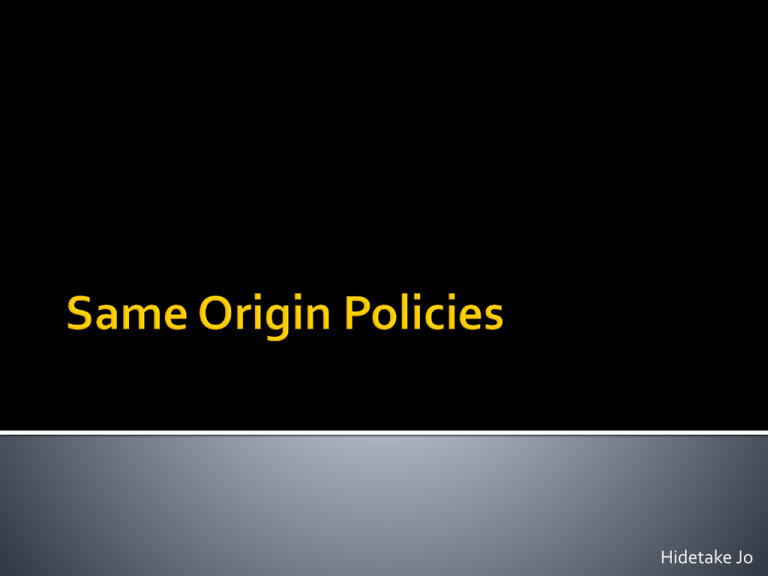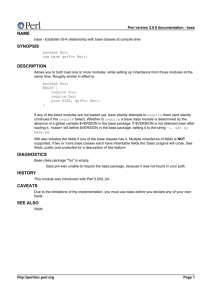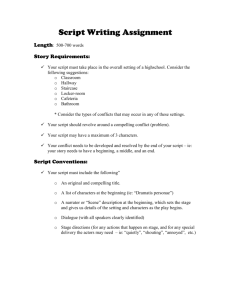SameOriginPolicy
advertisement

Hidetake Jo
A security policy for the web
Access from http://www.example.com/dir/test.html
Meant to prevent cross-site issues
Evil.com can’t access content from bank.com
Simple enough, right?
SOP is implemented everywhere
Browser features, RIA plugins, etc.
SOP is implemented differently
Neat but dangerous
Makes web developers life very interesting
High level overview of..
Same Origin Policies by technology
▪ Browsers, Javascript, Cookies, RIA, etc
Summary of deltas
How this affects us
Conclusion
Get/Post request can be made from one domain to another.
Example.com
Request
*
Get/Post response can only be read under the following
conditions:
If the ports match on both sites.
If the domain + subdomain match on both sites.
Example.com
Response
Example.com
Example.com:80
Response
Example.com:80
Example.com:80
Response
Example.com:100
Example.com
Response
Foo.Example.com
Example.com
Response
Different.com
Exceptions
If two different subdomains (different origin) is under the
same domain.. And one is performing domain lowering.
▪ Clock.live.com vs Vulnerable.live.com
▪ Clock.live.com setting document.domain to live.com.
▪ Vulnerable.live.com is owned then attacker can set domain to
live.com and access clock.live.com!
▪ Threats: All eggs in one basket (*.google.com or *.live.com). Crosssubdomain communication.
Domain Lowering
Putting all the eggs in one basket
Cross-Site Request Forgery
Netflix
▪ http://www.webappsec.org/lists/websecurity/archive/20
06-10/msg00063.html
Get/Post request for adding movie to queue
Get/Post works cross-domain…
If you’re including or exposing resource cross-domain such as
JSON, SCRIPT, etc
Script
▪ Forfeit trust to site exposing the script resource
XML/JSON
▪ Risk information disclosure if you’re exposing resource
▪ E.g. Read content of script, access JSON array, retrieve XML data.
▪ JSON: var data = { "social": "11-22-3333", "name": "Joe"};
▪ XML: var data = <info><social>11-22-3333</social><name>Joe</name>
Example.com
Response
Example.com
Example.com:80
Response
Example.com:80
Example.com:80
Response
Example.com:100
Example.com
Response
Foo.Example.com
Example.com
Response
Different.com
Javascript\XML Hijacking
Gmail
▪ http://jeremiahgrossman.blogspot.com/2006/01/advanc
ed-web-attack-techniques-using.html
Exposed script contained contacts info
Script path was fully predictable
Script can be included x-domain
Script content can be accessed
Variables
Functions (e.g. function_name.toString() )
Cookies by default permit read/write access to cookie values if:
The domain is the same (Limited subdomain check)
▪ Foo.bar.com bar.com
▪ bar.com foo.bar.com
Does not respect port numbers!
Does not respect scheme
▪ Unless you opt in to secure attribute
Example.com
Response
Example.com
Example.com:80
Response
Example.com:80
Example.com:80
Response
Example.com:100
Example.com
Response
Foo.Example.com
Example.com
Response
Different.com
Foo.bar.com can steal/poison cookie on
bar.com.
Foo.bar.com:1111 can steal/poison cookie on
Foo.bar.com:2222.
With regards to cookie and subdomains and
ports are of limited security boundary.
IE does not use ports during origin calculation.
You can read/write/script between:
▪ Bar.com:80 and Bar.com:1234
Example.com
Response
Example.com
Example.com:80
Response
Example.com:80
Example.com:80
Response
Example.com:100
Example.com
Response
Foo.Example.com
Example.com
Response
Different.com
Hosting multiple web apps on different ports
Should be avoided when possible
Ports are not a security boundary for IE
Host web apps on separate domains
You can not issue request cross-domain.
You can only read response on the same
domain.
Most restrictive Same Origin Policy
But it allows you to insert arbitrary header
value when issuing request. (e.g. SOAPAction
header)
Example.com
Request
Example.com
Using declarative security
Permits you to expand origin
▪ This is an opt-in policy/feature
▪ Access-Control-Allow-Origin/Method Header
Allows you to send request cross-domain
Allows you to read response cross-domain
More Info:
Cross Origin Resource Sharing (Firefox 3.5, Safari 4.0)
▪ http://www.w3.org/TR/access-control/
XDomainRequest Object (IE8)
▪ http://msdn.microsoft.com/en-us/library/cc288060(VS.85).aspx
Overly permissible policy
Kind of like ACL on Windows.
Tempting for frustrated developer to give
everyone full control.
Site where the binary lives is origin.
Site where the binary is embedded is also considered origin in
some cases.
App.xap lives in foo.com and a page on bar.com is using it. App now
has access to bar.com and foo.com.
▪ Read/Write DOM on bar.com
▪ Make network requests back to foo.com
Lock these RIA runtimes down:
Cross-domain policy files
▪ For Flash and Silverlight
▪ Easy to mess up: Tom found a major site that allowed all sites on the internet to read/write to
their site for over a year..
Embed these applets with security flags.
▪ Silverlight:
▪ EnableHtmlAccess
▪ Flash
▪ AllowScriptAccess
Hosting potentially evil RIA files
Can make network connection back to your host
Embedding potentially evil RIA files
Can script on your site
Hosting overly permissive policy files
Can read and write against your domain
Flash
flash.net.SharedObject
▪ Capacity: 100KB by default (adjustable)
▪ Same Origin Policy
▪ By Domain
▪ By User
3rd Party Content (enabled by default)
Silverlight
System.IO.IsolatedStorage.IsolatedStorageFile
▪ Capacity: 1024KB
▪ Same Origin Policy
▪ By User + Assembly
▪ By User + Domain + Assembly
HTML 5 Feature
Enables cross-domain Communication
target.postMessage(msg, origin)
Can implemenet listener by calling
target.attachEvent(“onmessage” , handler)
target.addEventListener(“message”, handler, useCapture)
Origin check in handler optional
Lack of optional origin check
Trusting potentially malicious origin
If no origin check is done by design
Sanitize incoming message before use
In addition to Get/Post there is Put/Delete
support for forms in HTML 5
Html 5 Spec supports this via form
Hopefully this will not be allowed x-domain!
Html 5 Feature
Enables bi-directional binary/text comm.
Still unclear how it will be secured
Enable cross-domain communication.
Up to dev/test/pm to define the policy.
Red flag!
Sitelock technique
Contain usage to one domain. (Different from SOP)
Generally should follow the same-origin policy…
But which one???
▪ The strictest definition to be safest.
▪ Port, Domain, Subdomain, Protocol should match for
read/write access.
My attempt at a summary table…
Cross-domain Get/Post can introduce CSRF.
Incorrectly configured RIA policy files and apps can
introduce cross-site access.
Lenient subdomain rule for cookie access makes
hosting multiple sites a challenge.
Cross-domain resource sharing of script, json, xml, etc
can introduce hijacking problems.
IE doesn’t utilize port for origin calculation. Web apps
should be hosted on distinct domains.
One-off x-domain apis such as postmessage can catch
developers off guard.
Etc..
We’re in a bad state with varying definition for same-origin policy.
Hard for developers to understand the risk with their design.
Audit all the areas that can go wrong:
Webservices that return includable data.
New ActiveX controls.
Features that leverage RIA platforms.
Crossdomain policy files
Declarative security flags
Usage of apis that permit x-domain access by design
Web service that permits state changing operations
Topology of the web app setup.
Etc.
There are other other technology that needs
to be looked at:
Gears, Air, Java, HTML 5 features, etc.
Same-origin policy is inconsistent today.
It will probably continue to stay this way.
For compat reasons…
The same-origin policy will probably evolve.
Hence the definition in this deck may be obsolete
soon.
If you have questions, concerns, corrections
please mail me at: hidejo@gmail.com






